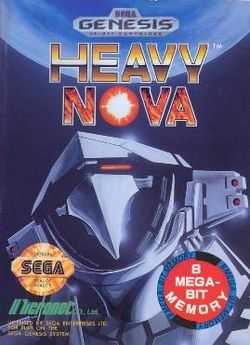Heavy Nova (video game)
| Heavy Nova | |
|---|---|
 | |
| Developer(s) | Holocronet |
| Publisher(s) | Micronet |
| Platform(s) | Sega Mega-CD, Mega Drive/Genesis, Sharp X68000 |
| Release date(s) | Mega-CD
|
| Genre(s) | Fighting, platform |
| Mode(s) | Single-player |
Heavy Nova (ヘビーノバ) is a video game for the Sega Mega-CD, Sega Mega Drive/Genesis, and Sharp X68000 that combines elements of fighting games with platform games and mission elements. It was released in 1991 and distributed to Japan and the United States and quickly became known as kusoge. Players assume the role of a robot operator destined to earn the highest operator rank. To do so, the robot – known in the game as a Heavy DOLL – must complete a combat training camp which prompts the 2D Platformer stages. The player then must combat other Heavy DOLLs as the end-level bosses which prompts the 2D fighting elements.
Story
Sometime in Earth's future, it came to mankind's realization that the Earth's natural resources were starting to decline, but despite every nation's attempts, the Earth's environment and resources continued thin. Suddenly, an alien race appeared in the Solar System. Hailing from the planet Akirov, the aliens had been observing Earth for centuries and arrived in order to save it. With their technological help, Earth's environment was replenished and Human's were able to travel deeper into space. By the year 2102, mankind was finally at peace thanks to the Akirovians.
Ten years later, a plot to enslave mankind was discovered to be a part of the Akirovian's plans and a war waged between the two. Eight years later, the Akirovians lost and left the Solar System. The primary machines for Earth's victory came from original Akirovian designed machines: giant remote controlled robots first used to design and repair Earth's satellite and colony structures. The robots were favored as Earth's primary line of defense and were dubbed the Heavy D.O.L.L's (Defensive Offensive Lethal Liberator).
Now taking place in 2120, the prospect of earning the highest combat ranking for a Heavy D.O.L.L, the rank of Heavy Nova, has become a long desired military rank. The player assumes the role of such a person attempting to earn that rank who must go through training and combat situations to prove their abilities.
Gameplay
| Reception | ||||||
|---|---|---|---|---|---|---|
| ||||||
Heavy Nova's Single Player game play is separated into two sections: a Platformer section and a Fighting Game section. The player has to destroy every possible enemy robot in the Platformer sections and make it to the end in order to fight the boss awaiting them. The player has various attacks at their disposal with the Idar, most of which they were able to use during combat with the bosses in the Fighting Game stages. During the Fighting Game Stages/Boss Fights, the player had to defeat the boss using various Fighting Game attacks such as a button command that allowed missiles to launch from the Idar's hand. However, both Heavy D.O.L.L robots, player and enemy, has an energy bar under their health meter; the energy bar measures how much strength the player or enemy has in order to move their robot. Taking too much damage results in energy depletion. Once the player's energy was depleted to two bars, the player robot cannot move, leaving the player completely vulnerable to enemy attacks.
Alternatively, the 2 Player mode pitches two players against each other using all of the enemy robot models encountered in the game.
Reception
Heavy Nova received very negative reviews. Mega said that "badly animated robots, appalling music and terribly unresponsive controls as much fun as colouring in each square on a piece of graph paper with a different pen... with a headache... listening to Max Bygraves." Classic Game Room's Mark Bussler praised its intro cutscene, but called it "possibly the worst video game I've ever played", criticizing the clumsy controls, uninspired level design, and flawed collision detection that turns the boss fights into a matter of "simply mashing buttons and hoping for the best".[2]
References
- ↑ Mega rating, issue 15, page 77, December 1993
- ↑ Classic Game Room review, May 13, 2008